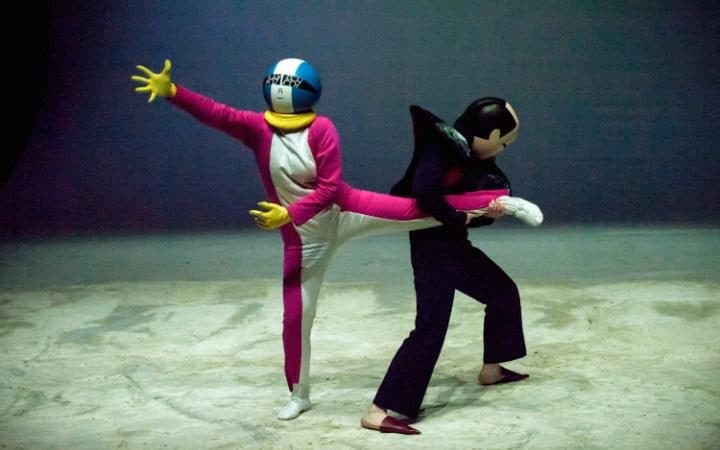Italian company Dewey Dell collaborates with Japanese director Kuro Tanino and visual artist Yuichi Yokoyama to create Marzo referring both to the month of March, and the god of war that month is named after. Marzo sets its audience up for a mighty and surreal work. Upon entering the Barbican Pit, we are handed ear plugs and sit down to seats that shake and reverberate from the pulsating soundtrack. A slightly intimidated audience prepare to watch with trepidation…
Viewers are confronted with a curved cyc that distorts any sense of depth by eliminating the horizon. The latex-coated pattern on the floorcloth provides a textured grounding for three superheroes to descend and battle in a sci-fi world. Marzo is based on Japanese Manga magazines which are visually stylised and evoke an ‘other’ world and culture.
One distinct feature of Manga is that they read backwards. Here, fitting the tradition, the plot starts at the end with the main content of the narrative forming a flashback of how the female protagonist, dressed in a pink boilersuit, meets her fate. But to me her character lacks heroism and she alternates between an object of hatred or desire of the two male superheroes, one of whom turns bad in a crude plot twist. Traditionally popular with teenagers, Manga magazines grew to include a diverse range of female authors for a female readership. There is a tension between female objectification and an attempted heroism that muddies the role of the female protagonist in Marzo. The excessive stroking of a phallic projection on one of the male super hero’s helmets is a particular low point.
Marzo’s stock characters, although stunningly dressed like superheroes who have jumped out of a comic, struggle to communicate with the audience from behind their masks. The three heroes, dressed in boilersuits and helmets, bicker between one another in a series of over-extended scenes. A chorus line of inflatable shapes attempt to control their actions in a choreography where they mirror the movements of the main characters. With punches and kicks and a repetition of posed lunges, the movement feels like a base demonstration or mime of an action or feeling, lacking the complexity and nuance that both dance and physical theatre vocabularies offer.
The world that Marzo creates is exciting, strange and striking in terms of colour and design, but it is a world I find hard to appreciate without the understanding of the culture that gives Manga its identity. The helmets that cover the faces of all on stage, whilst creating a mysterious sense of drama, inhibit the expression of action and an emotionally wrought narrative. Marzo is dressed beautifully and accompanied by a striking soundtrack. With a tighter grasp on the narrative through a deeper exploration of movement, the work could become a much stronger contender.

